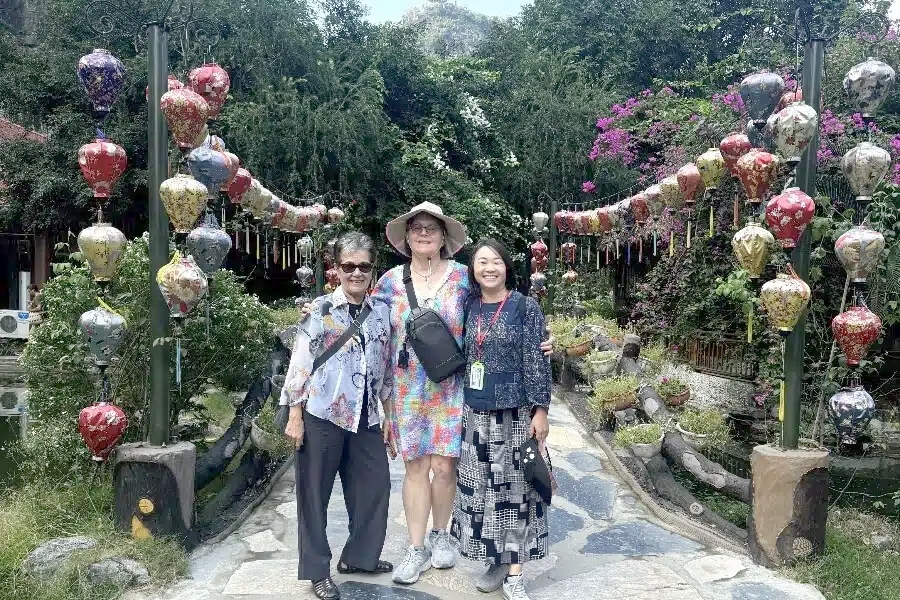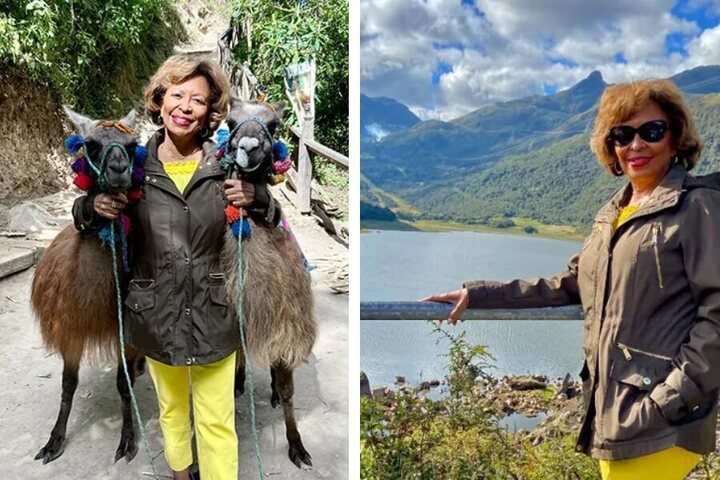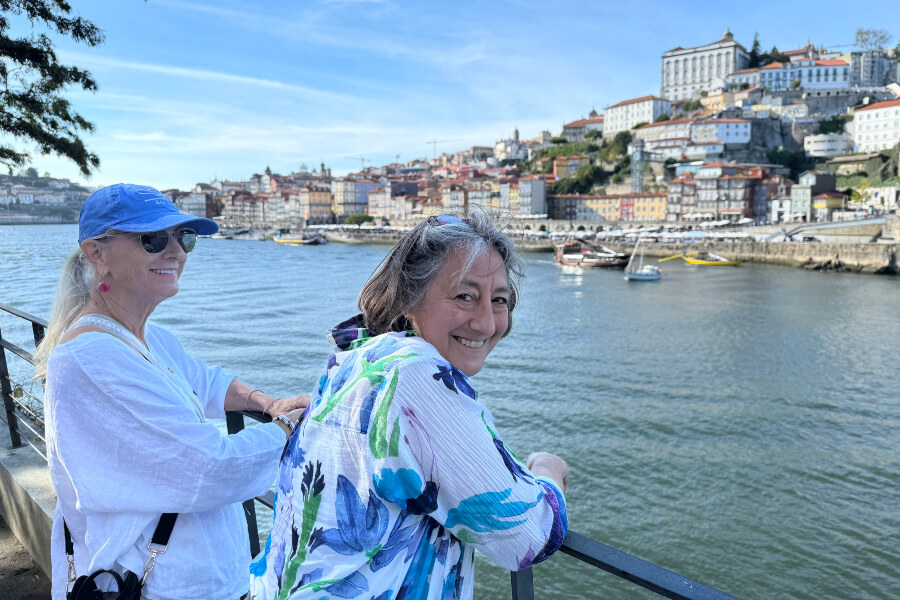As I walked through the arrivals terminal at Berlin-Tegel Airport after an overnight flight from New York, a disembodied voice chirping Willkommen to Deutschland undid me. I mashed my face into my partner Paul’s chest, muttering, “Being here feels too real. Can we go home?”
He squeezed as much of me as possible through my voluminous purple parka, saying, “I’m with you every step of the way.”
Paul squeezed me, saying, ‘I’m with you every step of the way.’
The last time I’d stepped foot in Germany was January 1984, when I traveled from Queens, NY, to Bochum with my father, a Holocaust survivor. I was there to offer support while he gave testimony against an alleged Nazi nicknamed “The Boxer” for his brutality toward Jews in Lodz, Poland, my dad’s hometown. My mom, also a survivor, couldn’t bring herself to make this pilgrimage; I certainly didn’t blame her. The trial ended without a conviction, as witnesses could not definitively state the defendant was the man who’d brutalized them.
Holocaust pain is pretzeled into my DNA—a justly earned trans-generational trauma. I suffered nightmares of big-booted Nazis chasing me; I felt kicked in the belly when a longtime neighbor, an Italian woman, said to my mother over coffee and rugelach, “You’re not a cheap Jew, Bernice, but many of your people are.” I endured dinners with extended family where inevitably someone would bring up the old days at camp.
Child of Holocaust Survivors: Making a Leap

The author speaking at the Healing Summit.
My life’s mission was to never cause my parents pain after all they had been through. Which is why for three and a half of the four years that Paul and I dated in the early ‘90s, I never brought this sweet, loving soul home. His fatal flaw? Not being Jewish. When I finally confessed my sin, my mother proclaimed, “I’ll give you a shovel. Dig a hole and your father and I will jump into it!”
Mom (wrongly) took credit for my eventual romantic breakup, years later writing me a letter, “I’m so sorry, Sherry. I didn’t know he was your last chance.”
The goal was to explore ways to promote concepts like tolerance and forgiveness.
My parents are long gone, but I believe they’d be glad Paul and I reunited nearly 30 years later. I’m not as sure how comfortable they’d be with my decision to visit what for them had been absolute hell.
I’d never considered checking out Travelocity deals to Germany, but then I was invited to speak at a summit of leaders in the wellness industry (I’m a psychotherapist). The goal was to explore ways to promote concepts like tolerance and forgiveness. It seemed like an amazing opportunity—one that promised to loosen the knots of reignited fear and sorrow that had been lodged in my stomach since the day Trump announced his candidacy and began spewing hate.
Ich Bin Ein Jew

The author walking through the Holocaust Memorial in Berlin (also pictured in large photo at the top of this article). Image: Paul Kelly
Standing at the ballroom’s podium of the ornate Hotel de Rome near Bebelplatz Square, I stared out at rows of smiling faces. I glanced at Paul, filming me with his iPhone, and then hesitantly began my speech about the importance of revealing our authentic selves.
I talked about the shame I felt in my early 20s when I worked at a magazine and allowed my publisher to put a phony non-Semitic name on the masthead above mine. Why? Though it was never said out loud, the reason for the deception was clear: There were too many Jews on the editorial staff. The audience applauded when I described the moment, three years into the charade, that I cleaned out my desk: “My parents were Holocaust survivors—how could I say I honored their legacy and lived in a way that brought pride to my people if I let this travesty continue? I felt free for the first time in a long while.”
I said, ‘You are giving me the courage to view some places in Berlin I didn’t think I’d be able to handle.’
During the cocktail hour, Josef, 50ish, soft-bellied, with the eyes of a wounded Labrador said, “Your story moved me immensely. I’ve visited several concentration camps. Sometimes I feel ashamed to be German.”
Suddenly I was light-headed, untethered to the earth, telepathically burrowing into the essence of this empathetic native Berliner. Those knots in my stomach began to untangle. We hugged, and I said, “You are giving me the courage to view some places in Berlin I didn’t think I’d be able to handle.”
He replied, “You don’t have to put yourself through anything. You’ve been through enough.”
I snorted, “Ha, Jews are made to suffer.”
Confronting Horror—and Hope

The author with the guide. Image: Paul Kelly
For our last day in Berlin, Paul and I booked a private tour with a Jewish company to visit Holocaust Memorials. Declaring my pride in being a Jew at the summit—and having that statement met with warmth and acceptance by Josef and others—did close a few fissures of pain, but today’s outing would surely be triggering.
Our guide Carolyn understood my apprehension. She was a writer who helped Holocaust survivors pen memoirs such as The Unwritten Diary of Israel Unger. Off we went. Our first stop was the Memorial to the Murdered Jews of Europe, a sloping field near the Brandenburg Gate containing 2,711 grey concrete stelae, or slabs. I walked deeper into the labyrinth, feeling like an animal led to slaughter. Two teens jabbering as they wedged themselves between two stelae to take a selfie jolted me back to self-hood.
“I’m done here,” I announced.
Next we visited the Levetzowstrasse Deportation Memorial. Once the location of Berlin’s largest synagogue, capable of holding 2,000 worshippers, it became a collection point for imprisoned Jews. Approximately 55,000 of the 160,000 Jews in Berlin circa 1933 were murdered—sickening numbers to contemplate.
I visualized my father, his parents, and his siblings on their way to Auschwitz.
I stared up at the obelisk inscribed with dates of all the transports—the final one was April 1945—then walked up the ramp to the old train car. I felt frozen in place as I stared at the memorial’s most gut-wrenching element: marble figures representing Jews huddled together, awaiting their fate. I visualized my father, his parents, and his siblings on their way to Auschwitz.
Carolyn pointed across the street toward a school and said, “Three times a year to commemorate the Holocaust, children stand outside and read the names of the dead for upwards of 13 hours.”
“That’s wonderful,” Paul and I exclaimed in unison. I rarely pray, but I do ache to find meaning in atrocity. One example of that meaning would be if future world leaders truly understood the urgency of treating those who are different with kindness.
Finding Peace of Mind Where I Least Expected It
Carolyn showed Paul and me evidence that pockets of decency existed in Berlin, even during the war:
- The gold dome-topped Neue Synagogue. It was saved from burning on Kristallnacht by the police chief, who fended off Nazis with a gun.
- Museum Otto Weidt’s Workshop for the Blind. This gentile factory owner not only bribed the Gestapo to save his workers—mostly blind and deaf Jews—he also hid nine people in a 15’ x 6’ space in his back room.
- The Block of Women. This ensemble of female sculptures symbolizes the sole public protest against the Nazis. On February 27, 1943, some 2,000 Jewish husbands of Aryan women were arrested and held at what had been a Jewish center on Rosenstrasse. For six days and nights, hundreds of women staged a peaceful protest outside the center, standing their ground even when threatened by Gestapo wielding machine guns and shouting, “If you don’t go, we’ll shoot.” Their husbands were released. (Yup, women getting it done!)

The Block of Women sculptures. Image: Sherry Amatenstein
I was still processing all this when Carolyn pointed out a nondescript square alongside the river Spree. This spot is slated to become The House of One, which will have a mosque, church, and synagogue under one roof! The website invites donations for the building—it costs 10 Euros to buy one stone.
I was amazed by Berlin’s evolution: It had gone from the epicenter of intolerance to a place that offered multiple religions the opportunity to worship together. The city’s transformation awakened in me a kernel of hope for the future.
As we lingered in front of the square, I said to Paul and Carolyn, “Who knew coming to Germany would be my anti-Trump vaccine?”
***
Sherry Amatenstein, LCSW, is a NYC-based therapist, author of three relationship self-help books and editor of the anthology How Does That Make You Feel: True Confessions from Both Sides of the Therapy Couch. She has contributed to many publications including New York, Washington Post, This Week, Reader’s Digest, Observer and vox.com.
Further Reading
Children of the Holocaust: Conversations with Sons and Daughters of Survivors
Five Chimneys: A Woman Survivor’s True Story of Auschwitz
The Boy on the Wooden Box: How the Impossible Became Possible . . . on Schindler’s List




















0 Comments